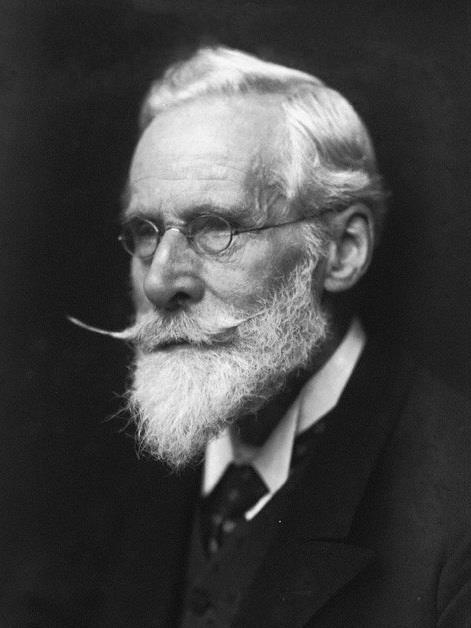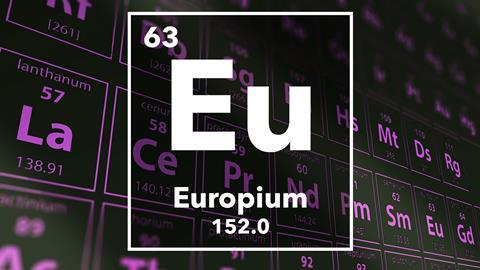Chris Smith
Hello, this week we're uncovering the origins of the element that put red into colour TV and also spawned a row with France, so I suppose there's nothing unusual there.
Brian Clegg
Many countries are honoured in the periodic table. There's americium, germanium, polonium, and francium, to name but a few. Usually these place names reflect where their discoverer worked. But despite the number of elements first isolated in England – ten were found at the Royal Institution in London alone – there is no Englandium, Unitedkingdium or Brittanium. However, there is europium, which allows for the possibility of a UK discoverer.
Europium is a lanthanide, one of those unfamiliar elements sitting outside the main structure of the periodic table. With atomic number 63, it inhabits the bar of elements that squeeze numerically between barium and hafnium. Along with scandium and yttrium, these are sometimes called rare earth elements – something of a misnomer, as they're not that scarce, but the minerals they were originally found in were rare, hence the name.

Europium wasn't so much discovered as groped towards. The British connection here is English scientist Sir William Crookes, who worked both in chemistry and physics. Crookes is probably best remembered for his work with discharge tubes. He was investigating (the scientific term for 'messing around with') the effect of putting a high voltage across two electrodes inside a tube with most of the air sucked out. This produced an unearthly glow on the glass at the end of the tube. Crookes called this effect a cathode ray. It was eventually shown to be caused by a stream of electrons, and the Crookes tube was the ancestor of traditional TV screens and computer monitors.
But Crookes was also an active chemist. He discovered the element thallium and is credited by some with the discovery of our topic today, europium. In the late 1880s, Crookes noticed a new line in spectroscopic analysis of a mineral containing ytterbium and samarium. Spectroscopy is a technique that makes it possible to analyze a material by measuring the different colours of light that are absorbed by it, or radiated when it's heated, giving a unique visual fingerprint. Crookes believed he had spotted a new element - so in a sense discovered europium, but never isolated it.
Others acknowledge French discoverers – either Paul Lecoq de Boisbaudran, a prolific investigator of new elements, who also identified a set of new lines a couple of years later, or definitively Eugene-Anatole Demarçay, who produced a europium salt in 1901 (it took many more years to get to the pure metal). It was certainly named by Demarçay – which should come as no surprise, as no Englishman of Crookes' time would think of himself as European.

This is a good example of the way that scientific discoveries aren't cut and dried. History-of-science expert Patricia Fara draws a parallel between the discoveries of europium and penicillin. We generally award the accolade for finding that life-saving mould to Alexander Fleming, who found it, but didn't pursue it further, rather than the team that isolated penicillin. But for europium, many historians play events the other way round, ignoring europium's Fleming, William Crookes.
Even if Crookes isn't the discoverer, he still plays a part in europium's story because of cathode ray tubes. If you are listening to this podcast on a computer with a traditional colour monitor, europium will be enhancing your view of the Chemistry World website. When colour TVs were first developed, the red pixels were relatively weak, which meant the whole colour spectrum had to be kept muted. But a phosphor doped with europium proved a much better, brighter source of red and is still present in most surviving monitors and TVs that predate the flat screen revolution.

Doping is something of a speciality for europium. Doping involves adding a relatively small amount of a material to another to change its properties. This is often europium's role in phosphors, the materials used to provide a glow when stimulated by electrons in TVs, or by ultraviolet in fluorescent lights. As well as the red glow from the valency three version of europium, its valency two salts produce a blue radiance. These are both combined with a third phosphor to produce white light in compact fluorescent bulbs.
Another phosphorescent role for europium, where the name is particularly apt, is as an anti-forgery mark on Euro bank notes. Europium is also behind the action of the mineral that gives us the word 'fluorescent'. In fluorescence, a material absorbs relatively high energy light such as ultraviolet and gives off a lower frequency in the visible range, making the substance unnaturally bright. The same type of europium responsible for the blue phosphor in fluorescent lights is present in some variants of the mineral fluorite, and it was its blue glow that resulted in the word fluorescent being derived from the mineral's name.
Although technically a metal, europium lacks the familiar metallic shininess because it oxidizes so easily. This silvery/white material is never naturally found in the free state. If it's not reacting with air, it fizzes away in water to produce a hydroxide. Europium is also a great neutron absorber, making it an interesting possibility for damping nuclear reactors by hoovering up stray neutrons, though it hasn't been widely used for this to date.
So that's europium – the substance that brings colours to phosphors. It's somehow rather appropriate that the discovery of europium, the element named after the continent of Europe, should be the subject of a dispute between England and France. Some things, it seems, will never change.
Chris Smith
Brian Clegg with the story of Europium, the element that makes you see red, or at least it does on an old fashioned TV screen. Next week, the inside story on the element that just didn't want to be discovered.
Chris Orvig
vanadium, a first row transition metal in the Periodic Table, is an element of mystery. Not only was it first transported two hundred years ago from Mexico, and lost in a shipwreck along with all of the relevant lab notes by the great German scientist Baron von Humboldt, but it required discovery several times by such famous names as W?hler, Berzelius and del Rio (who was actually talked out of his claim in 1805).
Chris Smith
But why, and who did eventually discover Vanadium and what do we do with it today. To find out join Chris Orvig, on next week's Chemistry in its Element. I'm Chris Smith, thank you for listening and goodbye.













No comments yet